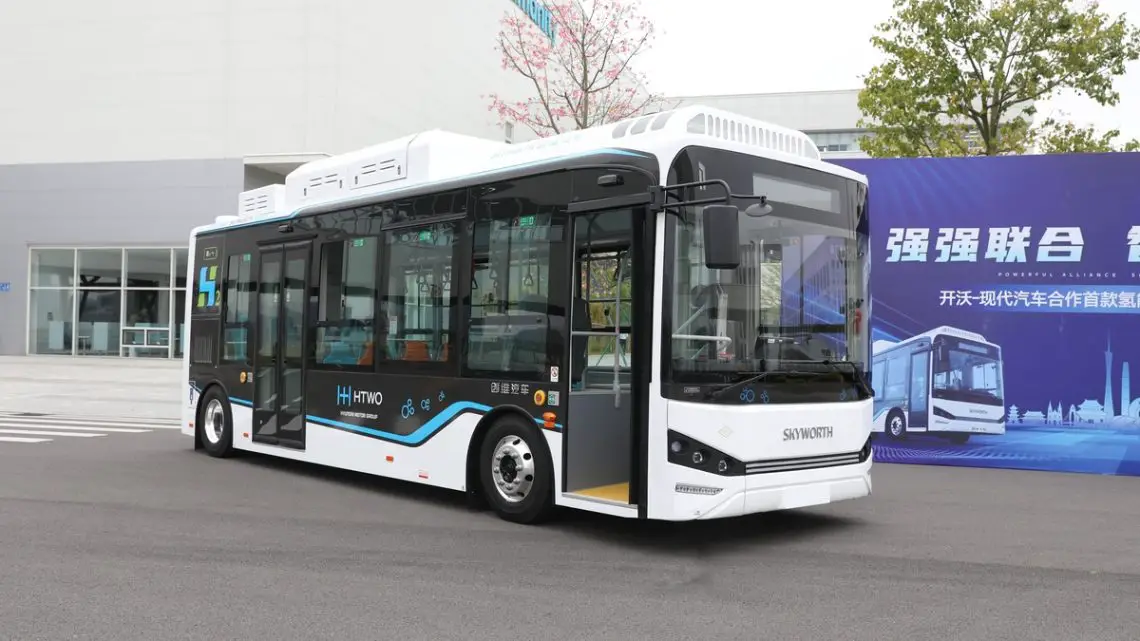
Hydrogen Fuel Cell Bus Leads Guangzhou’s Green Mobility Revolution
November 20, 2025Introduction: Setting the Scene in Guangzhou
Picture this: Guangzhou, home to nearly 19 million residents and a historic trade hub, is making waves in Hydrogen Public Transport. On any given weekday, the city hums with life—traffic buzzing, people weaving through streets, that unmistakable energy of the Pearl River Delta. But there’s a twist: silent buses slip through both ancient alleyways and sleek glass towers, leaving nothing behind but water vapor. That shift kicked off on November 5, 2025, when HTWO Guangzhou, Hyundai’s dedicated hydrogen fuel-cell arm in China, teamed up with the trailblazing Skywell New Energy to roll out an Hydrogen Fuel Cell Bus measuring 8.5 meters long. They’ve already locked in a deal to deliver half of the 50 buses scheduled to join Guangzhou’s streets in 2025—a key move in the city’s Guangzhou Green Mobility push.
Collaborating to Drive Change
Getting two global titans to sync up like this isn’t an everyday sight. On one side, Hyundai Motor Group leaned on decades of refining fuel-cell R&D through its HTWO Guangzhou arm, pouring resources into local partnerships, pilot programs, and tailored tech. On the other, Skywell New Energy earned its unicorn stripes by rapidly developing commercial EVs and hydrogen buses, then forging smart alliances with public transit operators. When Guangzhou put out the call for medium-capacity, hydrogen-powered buses, these teams came together and snagged the contract to outfit the city’s Hydrogen Public Transport network. The cherry on top? This deal opens doors to international markets, putting Hydrogen Fuel Cell Bus technology in the fast lane as China races toward carbon neutrality.
Historical Context: China’s Hydrogen Momentum
Hydrogen fuel cell vehicles once felt like sci-fi prototypes—back in the ’90s, they mostly lived in labs. Fast-forward to now, and they’re cruising through one of China’s busiest metropolises. What flipped the script? Government backing via the 13th and 14th Five-Year Plans, all steering toward the ambitious 2060 carbon-neutrality goal. Overseas experiments in cities like London and Cologne during the late 2010s, plus South Korea’s push ahead of the 2018 Winter Olympics, grabbed Beijing’s attention. That international buzz spurred companies such as Hyundai and Skywell New Energy to supercharge their R&D and pilot efforts. So when Guangzhou announced its hydrogen fleet, it wasn’t a shot in the dark but the result of years of global collaboration and domestic fine-tuning.
Tech Spotlight: The 8.5-Meter Hydrogen Fuel Cell Bus
What makes this Hydrogen Fuel Cell Bus tick? It’s all down to Hyundai’s HTWO Guangzhou fuel-cell stack. Picture a compact power plant on wheels: hydrogen gas enters the stack, meets oxygen at a special membrane, and—voilà—it generates electricity and nothing but water vapor. The result? Smooth, near-silent acceleration without a hitch.
Even better, the bus captures extra energy during braking and tucks it away in an onboard battery, squeezing more juice out of every stop-and-go. Thanks to the modular design, operators can scale power up or down—perfect for busy downtown routes or quieter suburban loops. And topping up takes mere minutes, mirroring a diesel refill time, so schedules stay on point. Fewer moving parts mean maintenance shifts from oil changes and engine overhauls to software tweaks and quick stack inspections, promising operators long-term savings.
Impact: Scaling Clean Transport in Guangzhou
Rolling out 25 buses might not feel seismic on its own, but when paired with another supplier’s 25 units, it marks Guangzhou’s first full-scale push into Hydrogen Public Transport. This 50-bus fleet is a cornerstone of the city’s mission to slash greenhouse gases and curb local air pollution—directly supporting China’s carbon-neutrality roadmap. Even cooler? By sourcing hydrogen locally, the project fuels regional supply chains, from electrolyzer factories and tanker logistics to refueling stations and maintenance depots, paving the way for other megacities to follow suit.
From a rider’s perspective, the perks are plain: whisper-quiet trips that make for a more relaxing commute, and a drivetrain with fewer parts means less chance of unexpected breakdowns. For fleet operators, that adds up to less downtime, lower lifecycle costs, and the freedom to focus on growing the network rather than chasing spanners.
Regional and Global Impacts: A Tipping Point
This launch is about more than clearing the skies over Guangzhou—it’s a domino waiting to fall across the hydrogen transport landscape. As demand for locally produced hydrogen climbs, expect new ventures sprouting up around electrolyzer manufacturing, tanker distribution, and station operations, creating scores of engineering and operations jobs.
Over 50 cities in China have dipped their toes into hydrogen bus pilots, but few have gone all-in on a fleet this size. Guangzhou’s 50-bus program could tip the balance, nudging other Tier-1 and Tier-2 cities to level up their Guangzhou Green Mobility efforts. And it’s not just home turf—transit agencies in Europe and North America are watching closely, scouting for inspiration to turbocharge their own decarbonization plans. When one major city pulls off something this big, it can reshape policy, investment flows, and public buy-in worldwide.
A Glimpse into the Future of Hydrogen Mobility
You might be wondering: what’s next on this journey? This landmark deployment sends a clear message: hydrogen fuel cell technology is ready for the main stage. If the HTWO Guangzhou and Skywell New Energy buses keep proving their mettle, we’ll likely see a wave of new R&D funding, deeper Korea–China tech partnerships, and an accelerated spread of hydrogen solutions across trains, ships, and even planes.
Beyond buses, the same core Hydrogen Fuel Cell Bus tech could power heavy-duty trucks, delivery vans, and stationary power units, turning hydrogen into a powerhouse across multiple sectors. Guangzhou’s success story is poised to light up clean transport conferences and climate summits, nudging regulators and investors worldwide to back even bolder projects. In the end, these silent, water-vapor-emitting buses aren’t just a neat sight—they’re proof that zero-emission public transport is here, it works, and it’s just getting warmed up.


 With over 15 years of reporting hydrogen news, we are your premier source for the latest updates and insights in hydrogen and renewable energy.
With over 15 years of reporting hydrogen news, we are your premier source for the latest updates and insights in hydrogen and renewable energy.